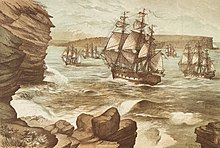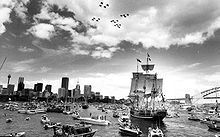First Fleet


As First Fleet ( German First Fleet ) which is fleet referred to ships which on 13 May 1787 Portsmouth in England left to Australia to settle. A total of 756 prisoners and 550 crew members were on board . The commander of the eleven ships was Captain Arthur Phillip .
background
At the end of the 18th century, Great Britain was urgently looking for a permanent solution for the deportation of prisoners. Convicts had been exiled to North America since 1611, but with the start of the American Revolutionary War in 1775 and the recognition of the United States in 1783, this was no longer possible. As a way out, convicts were housed on disused and dismantled warships ( Hulks ), on the Thames and elsewhere, where they vegetated in catastrophic conditions. For fear of epidemics and revolts, Interior and Colonial Minister Lord Sydney convened a committee of experts to find a new place of exile. One fell in love with Botany Bay in Australia, which, according to James Cook's reports, seemed suitable.
At the beginning of 1787 the first offenders who had been sentenced to several years' exile - often for relatively minor crimes such as theft of food - were brought from dungeons and hulks onto the ships. The youngest was John Hudson (13 years), the oldest Elizabeth Beckford (70 years).
travel
The fleet set sail on May 13, 1787. The first stop was in Tenerife , where fresh meat and water were taken. In Rio de Janeiro rum was bought for the marines, seeds and seedlings of plants from warm countries such as coffee, cotton, indigo and prickly pears. The last stop was at the Cape of Good Hope , where cattle, pigs, sheep and chickens were taken. Then the Roaring Forties crossed the Indian Ocean. Van Diemens Land ( Tasmania ) was sighted on January 1, 1788, and the first ships landed in Botany Bay on January 18. A few days later one met the ships of the La Pérouse expedition here .
Contrary to the reports by James Cook, Botany Bay proved unsuitable for a settlement. Looking for a better place, Arthur Phillip found Sydney Cove , a small cove in the natural harbor of Port Jackson . Ships reached this bay on January 26th, now celebrated as Australia Day .
The new settlement was named in honor of Lord Sydney Sydney called. The Supply sailed on to Norfolk Island in February , where another settlement was established.
Ships of the fleet
The fleet consisted of eleven ships:
Naval escort
- HMS Sirius , 511 tons, flagship
- HMS Supply
Convict transporter
Supply ships
Models of all ships are on display in the Museum of Sydney .
Nine harbor ferries in service in Sydney today are named after First Fleet ships ( Lady Penrhyn and Prince of Wales are not currently in use ).
Totals
| Departure from Portsmouth | Arrival in Port Jackson | |
|---|---|---|
| Officials and passengers | 15th | 14th |
| Ship crew | 323 | 269 |
| Royal Marines | 247 | 245 |
| Women and children of the Royal Marines | 46 | 45 + 9 newborns |
| Convicts (men) | 582 | 543 |
| Convicts (women) | 193 | 189 |
| Children of the convicts | 14th | 11 + 11 newborns |
| total | 1420 | 1336 |
The death rate was rather moderate for the time.
Composition by nationality
Among the 732 convicts were, in addition to the English and Welsh who could be identified, about 180 Scots and Irish, 14 North Americans, 12 Africans, 9 Jews and people from France, Germany, Norway, Portugal, India, Sweden and the West Indies Islands .
See also
Web links
- Individual illustration of all ships in the First Fleet
- A company of the descendants of the settlers of the First Fleet (English)
- Article on the First Fleet (English)
- List of prisoners of the First Fleet including their sentences (English)
- Australian site with all information about "First Fleet" (English)
Individual evidence
- ↑ Cathy Dunn: Australia's First Fleet - 1788. In: Early Colonial History (English)
- ↑ Geo Spezial Australien , Issue 6, 2013. Gruner + Jahr Hamburg, ISSN 0723-5194 .
- ^ First Fleet 1788. Abstract of Biographical Data from The Founders of Australia: A Biographical Dictionary of the First Fleet (PDF) at bda.online.org.au. Retrieved March 20, 2016